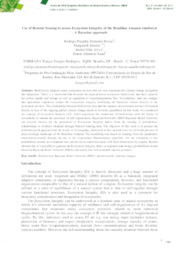Use of remote sensing to assess ecosystem integrity of the Brazilian Amazon rainforest: a Bayesian approach.
Use of remote sensing to assess ecosystem integrity of the Brazilian Amazon rainforest: a Bayesian approach.
Author(s): FERRAZ, R. P. D.; SIMÕES, M.; ALVES, A. O.; XAUD, H. A. M.
Summary: Biodiversity supports many ecosystem services that are very important for climate change mitigation and adaptation. There is a functional link between the tropical forest ecosystem biodiversity and their capacity for carbon uptake and storage as well as regulation of evapotranspiration flux. Nevertheless, land use changes and agriculture expansion reduce the ecosystems integrity modifying the functions related directly to the ecosystem services. The relationship between biodiversity loss and the impacts on ecosystem services of tropical forests, in face of the ongoing global climate change needs to be better quantified. In this work, we considered the concept of Ecosystem Integrity (EI), which represents the connection of biodiversity with the ability of ecosystems to sustain the processes of self-organization. Bayesian Networks (BBN-Bayesian Belief Network) can provide metrics for the generation of Ecosystem Integrity Index, from the training of probabilistic relationships of evidence obtained through Remote Sensing data. The objective of this work is to present the methodological approach and the results of EI mapping, elaborated at the regional scale for different patterns of phyto-ecologic landscape of the Brazilian Amazon. The modelling was based on learning from the parameters (data-driven model) through the use of the Expectation Maximization algorithm. For the validation of this probabilistic model, an evaluation was carried out in controlled areas with field observation by experts. Results showed that it is possible to generate an Ecosystem Integrity Index at regional scale using a probabilistic model based on Bayesian Belief Networks (BBN), and totally free web-available satellite products.
Publication year: 2017
Types of publication: Paper in annals and proceedings
Unit: Embrapa Soils
Observation
Some of Embrapa's publications are published as ePub files. To read them, use or download one of the following free software options to your computer or mobile device. Android: Google Play Books; IOS: iBooks; Windows and Linux: Calibre.
Access other publications
Access the Agricultural Research Database (BDPA) to consult Embrapa's full library collection and records.
Visit Embrapa Bookstore to purchase books and other publications sold by Embrapa.

